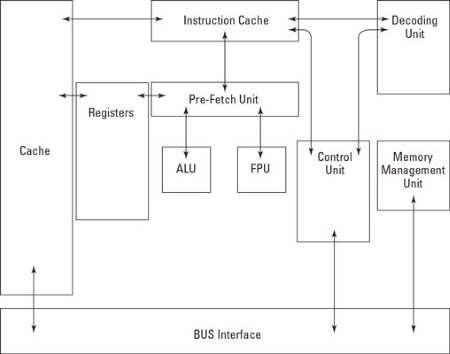Certified Information Systems Security Professional (CISSP) is an independent information security certification granted by the International Information System Security Certification Consortium. CISSP is a standardized, vendor-neutral certification program that provided structure and demonstrated competence relevant to information security professionals.
Basic computer (system) architecture refers to the structure of a computer system and comprises its hardware, firmware, and software.
Tip
The CompTIA A+ certification exam covers computer architecture in depth and is an excellent
way to prepare for this portion of the CISSP examination.
Hardware
Hardware consists of the physical components in computer architecture. The main components of the computer architecture include the CPU, memory, and bus.
CPU
The CPU (Central Processing Unit) or microprocessor is the electronic circuitry that performs a computer's arithmetic, logic, and computing functions. As shown in the figure, the main components of a CPU include
• Arithmetic Logic Unit (ALU): Performs numerical calculations and comparative logic functions, such as ADD, SUBTRACT, DIVIDE, and MULTIPLY.
• Bus Interface Unit (BIU): Supervises data transfers over the bus system between the CPU and I/O devices.
• Control Unit: Coordinates activities of the other CPU components during program execution.
• Decode Unit: Converts incoming instructions into individual CPU commands.
• Floating-Point Unit (FPU): Handles higher math operations for the ALU and control unit.
• Memory Management Unit (MMU): Handles addressing and cataloging data that's stored in memory and translates logical addressing into physical addressing.
• Pre-Fetch Unit: Preloads instructions into CPU registers.
• Protection Test Unit (PTU): Monitors all CPU functions to ensure that they're properly executed.
• Registers: Hold CPU data, addresses, and instructions temporarily, in special buffers.

The main components of a CPU.
BUS
The bus is a group of electronic conductors that interconnect the various components of the computer, transmitting signals, addresses, and data between these components. Bus structures are organized as follows:
• Data bus: Transmits data between the CPU, memory, and peripheral devices.
• Address bus: Transmits addresses of data and instructions between the CPU and memory.
• Control bus: Transmits control information (device status) between the CPU and other devices.
This is an excerpt from:
If you're a security professional seeking your CISSP certification, this book is a perfect way to prepare for the exam. Covering in detail all eight domains, the expert advice gives you the key information you'll need to pass the exam with flying colors. Plus, you'll receive guidance on setting up a study plan, tips for exam day, and access to an online test bank of questions. After you earn your CISSP certification, learn how to grow as a security professional and put your certification to good use. So, put the odds in your favor and get started today!
• How to prepare for the CISSP examination
• An in-depth chapter on all eight certification domains
• Advice on getting the most out of a CISSP certification
• Tips on studying for the exam and a stress-free test day
•
Click here for more information.
More Windows Administration Information:
• Beginner's Guide to Computer Forensics
• Five Critical Steps to Protect Your Personal Information and Computer
• Keep Your Internet Browsing Private with InPrivate Browsing
• The Windows Bootup Process
• Guide to Selecting the Right Spyware Removal Tool
• Easiest Ways to Beat Ransomware
• Set Windows Defender to Scan Core Operating System Files
• Computer Architecture, Main Memory, and the CISSP Exam
• Computer Architecture, Hardware domain of the CISSP Exam
• What Are WEP, WPA, TKIP, AES and PSK?


